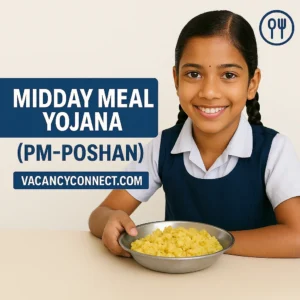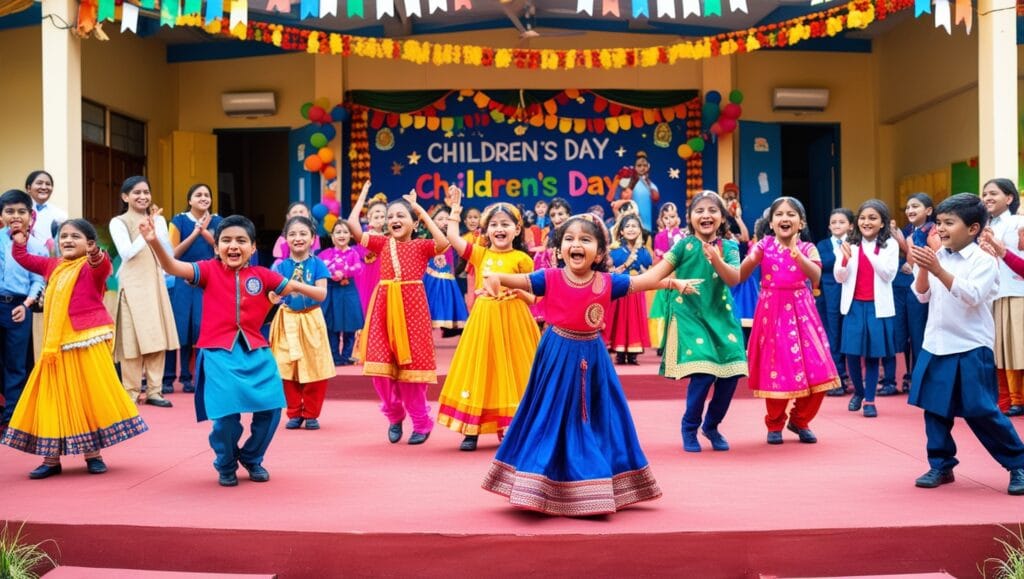Midday Meal Yojana (PM-POSHAN)
Overview
Midday Meal Yojana (PM-POSHAN) – Eligibility, Benefits & Complete Details
Midday Meal Yojana (PM-POSHAN) is one of India’s most impactful government schemes aimed at tackling childhood hunger and malnutrition while simultaneously boosting school education. As the world’s largest school meal program, it provides free, hot, and nutritious meals to millions of children enrolled in government and government-aided schools across the country.
By addressing the dual challenges of nutrition and education, the Midday Meal Yojana (PM-POSHAN) has become a cornerstone of India’s fight against poverty and inequality. In this article, Vacancy Connect brings you the complete notification about PM-POSHAN 2024, including eligibility, objectives, benefits, implementation, FAQs, and more.
| Feature | Details |
|---|---|
| Scheme Name | Midday Meal Yojana (PM-POSHAN) |
| Launched Year | 1995 (Renamed as PM-POSHAN in 2021) |
| Ministry | Ministry of Education, Government of India |
| Type | Centrally Sponsored Welfare Scheme |
| Beneficiaries | Children aged 6–14 years enrolled in Classes I–VIII of Government, Government-aided schools, Madarasas, Maqtabs, and Anganwadis |
| Objective | To fight hunger & malnutrition, improve school attendance, and enhance learning outcomes |
| Coverage | Over 11.8 crore children across 11.2 lakh schools in India |
| Nutritional Support | Primary (450 kcal & 12g protein) and Upper Primary (700 kcal & 20g protein) |
| Special Feature | Meals prepared & served hot in schools with community involvement |
Important Dates
| Event | Date |
|---|---|
| Initial Concept (Tamil Nadu – CM K. Kamaraj) | 1956 |
| National Scheme Launch | 15 August 1995 |
| Supreme Court Mandate for Cooked Meals | 2001 |
| Expansion to Classes VI–VIII | 2007 |
| Scheme renamed as PM-POSHAN | 2021 |
Application Fee
The Midday Meal Yojana (PM-POSHAN) is a government-funded social welfare program. There is no application fee for parents or students.
| Category | Application Fee |
|---|---|
| General | NIL |
| OBC | NIL |
| SC/ST | NIL |
| EWS | NIL |
Eligibility Criteria
| Criteria | Details |
|---|---|
| Age | 6–14 years |
| Education | Children enrolled in Classes I to VIII in Government, Government-aided schools, Madarasas, Maqtabs, and Anganwadis |
| Family Income | No income limit – scheme is universal for school-going children |
Beneficiaries
The primary beneficiaries of the Midday Meal Yojana (PM-POSHAN) are:
Children aged 6 to 14 years enrolled in Classes I to VIII.
Students of government schools, government-aided schools, Madarasas, Maqtabs, and Anganwadis.
Children from marginalized, economically weaker, and socially disadvantaged backgrounds.
Objectives of PM-POSHAN
The scheme serves two major objectives:
Nutritional Security – To fight hunger and malnutrition among school children by ensuring a daily supply of calories, protein, and micronutrients.
Educational Support – To increase enrollment, reduce dropout rates, and improve learning outcomes by making schools more attractive to children, especially from poor families.
Key Benefits of Midday Meal Yojana (PM-POSHAN)
Improved Nutrition
Provides 450–700 kcal and 12–20 grams of protein per child, per day.
Includes rice/wheat, pulses, vegetables, and sometimes eggs or milk.
Increased Enrollment
Parents are more motivated to send their children to school as meals reduce household food expenses.
Particularly effective in boosting girl child enrollment.
Enhanced Learning Outcomes
Well-fed children show better concentration, memory, and academic performance.
Studies link midday meals to higher test scores in mathematics and reading.
Economic Relief
Saves families from spending extra on meals.
Reduces financial burden for low-income households.
Social & Gender Equity
Children of all castes and communities sit together and eat, promoting social integration.
Encourages gender equality, as families are more willing to send girls to school.
Women Empowerment
Many states employ women’s self-help groups (SHGs) as cooks and helpers, providing income opportunities.
Community Involvement
Local communities and NGOs participate in monitoring and cooking.
Improves transparency and ownership.
Nutritional Standards under PM-POSHAN
| Category | Calories | Protein |
|---|---|---|
| Primary (Classes I–V) | 450 kcal | 12g protein |
| Upper Primary (Classes VI–VIII) | 700 kcal | 20g protein |
Food Groups Included:
Staples: Rice/Wheat
Pulses: Lentils, chickpeas
Vegetables: Seasonal & locally available
Extras: Eggs or milk in some states
Food Safety Measures
Procurement & Storage: Strict quality checks, pest-free warehouses.
Kitchen Hygiene: Mandatory sanitation protocols for utensils, water, and staff.
Cooking & Serving: Meals prepared fresh daily, served hot in schools.
Monitoring: Surprise inspections and food sample testing.
Role of State Governments
Financial Contribution: States share costs with the central government (approx. 40%).
Menu Flexibility: Menus adjusted based on local dietary preferences.
Monitoring & Inspection: Regular checks for quality, hygiene, and attendance.
Community Participation: Involvement of local self-help groups, panchayats, and NGOs.
How to Apply for Midday Meal Yojana
Parents do not need to apply separately for the scheme. Steps:
Enroll your child in a government or government-aided school.
Ensure regular attendance in school.
The school automatically provides free midday meals.

Important Links
| Link | URL |
|---|---|
| Notification | Click Here |
| About Scheme | Click Here |
| Sarkari Result | Click Here |
| Telegram Group | Join Now |
| WhatsApp Channel | Join Now |
| Official Website | Click Here |
FAQ –
Q1. Who is eligible under PM-POSHAN?
Children aged 6–14 years, studying in Classes I–VIII of government and government-aided schools.
Q2. What is the nutritional standard?
Primary children get 450 kcal & 12g protein, upper primary children get 700 kcal & 20g protein daily.
Q3. Do parents have to pay for meals?
No, the scheme is 100% free for all eligible children.
Q4. How is food safety ensured?
Meals undergo quality checks, inspections, and hygiene protocols.
Q5. How many children benefit from PM-POSHAN?
Over 11.8 crore students across India.
Head Office Address
Department of School Education & Literacy
Ministry of Education, Government of India
Shastri Bhawan, Dr. Rajendra Prasad Road,
New Delhi – 110001
Recent Posts
Upcomming Vacancies
- DSSSB Primary Teacher PRT Recruitment 2025 Apply Online for 1180 Posts
- RBI Grade B Officer Vacancy 2025 Online Form – Apply Now
- Exim Bank Officers Recruitment 2025 – Apply Online
- NHPC 248 Non-Executive Recruitment 2025 – Apply Online
- GSSSB 53 Post Recruitment 2025 – Apply Online
- DEE Assam 120 Special Educator Recruitment 2025 – Apply Online
- Telangana MHSRB Recruitment 2025 – Apply Online for 1623 Posts
